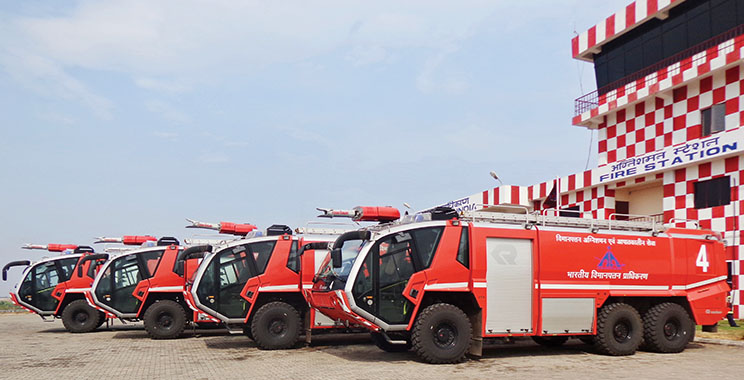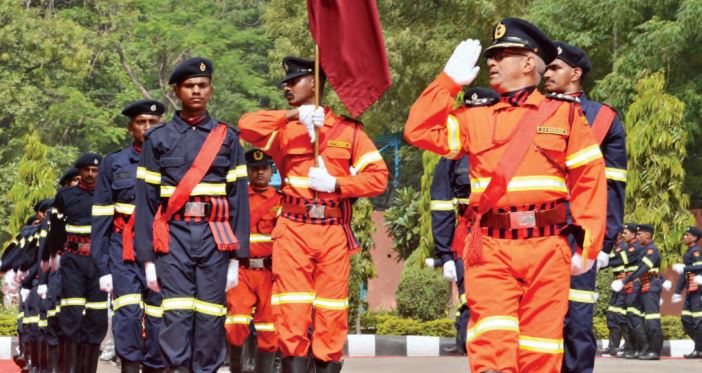FIRE SAFETY
AIBM
January - March 2018
The firefighting and rescue services of the AAI are key to maintaining safety at airports and relieving passengers of worry by ensuring that they are protected from incidents or accidents. To ensure optimum results and maintain a high standard of safety service, the AAIs top management has been making consistent effort for advancement in technology and training.
Airport Rescue and Fire Fighting (ARFF) services are vital for ensuring the safety of airport operations by ensuring rapid intervention, quick knock-down and swift rescue operations. The major areas of concern in the aviation field are aviation fuel, airport installation, passengers and aircraft movement. As per the statistics, most of the aircraft crashes occur on or within the vicinity of airport.
Aircraft fire fighting techniques are very complicated in nature, requiring high skills and training of very high standards. Multitasking skills are very important as fire control, suppression, rescue, medical triage, etc., need to commence simultaneously.
In AAI, these rescue and firefighting services are usually referred to as Airport Fire Services (AFS).
Role of Airport Fire Services
The principal objective of a rescue and fire fighting service is to save lives in the event of an aircraft accident or incident occurring at an aerodrome or around its immediate vicinity. The rescue and fire fighting services are provided to create and maintain survivable conditions, to provide egress routes for occupants and to initiate the rescue of those occupants unable to make their escape from the aircraft on fire without direct aid.
The most important factors responsible for an effective rescue operation in a survivable aircraft accident are: the training received, the effectiveness of the equipment and the speed with which personnel and equipment designated for rescue and fire fighting purposes can be put into use.
Level of Fire Protection
The number and type of firefighting appliances based at an airport will be determined by the airport’s category. Airports in the India are categorised from 01 to 10 depending on the type and size of aircraft they handle. The AAI’s Chennai and Kolkata airports are category-10 as they cater to the biggest aircraft, namely the Airbus A380, and therefore requires extensive rescue and firefighting cover as determined by the Directorate General of Civil Aviation (DGCA). Often the AFS will also be responsible for providing medical assistance during accidents. All the firefighters are trained and certified by St John Ambulance Association to provide first-aid.
Response Time
The operational objective of the ARFF is to achieve response time of two minutes not exceeding three minutes (in optimum visibility and surface conditions) to any point of each operational runway and for any other part of the movement area.
Response time is considered to be the time between the initial call to the ARFF, and the time when the first responding vehicle(s) is (are) in position to apply foam at a rate of at least 50 percent of the discharge rate specified for airport fire category.
A typical category 10 airport operates out of two fire stations in order to achieve the three-minute response time to any location within the airport boundary.
The ARFF services will respond to all aircraft emergencies within the airport’s boundaries and will also respond to ‘off airport’ incidents that fall within eight kilometres of the airport boundary. All incidents that occur outside of the airport boundary are the responsibility of the local fire and rescue service authority serving that location. While local firefighters are trained to deal with aircraft accidents, they do not receive the same level of training as airport firefighters, whose expertise is more specialised.
The ARFF do not respond to non-aircraft incidents off site, this would leave the airport without fire cover and lower the airport category. If an airport has no fire cover it has to close its runways to passenger aircraft as the safety of the passengers is of top priority. This would then cause major disruption for air travel and scheduled flights, which is why ARFF have to be on-site.
Other Incidents
Some of the other incidents that ARFF deals with include road incidents in airport, as well as chemical spillages, fires/rescues in airport buildings and special service calls on airport. Firefighters at major airports are specially trained to handle Chemical, Biological, Radiological and Nuclear (CBRN) emergencies in coordination with National Disaster Management Authority (NDMA). However, some incidents, wherever possible are passed onto the local authority/fire services so that the airport crews can return to give fire cover to the aircraft movement at the airport.
Fire Appliances
To meet the operational objective as closely as possible in less than optimum conditions of visibility, especially during low visibility operations, suitable guidance, equipment and/or procedures for rescue and firefighting services are provided. The firefighting vehicles and equipment used by AFS are the most advanced in terms of technology.
The number and type of firefighting appliances based at an airport will also be determined by the airport’s category. Since the category 10 airport requires extensive rescue and firefighting cover, the fire appliances used by ARFF normally consist of a fleet of large high-volume pumping vehicles known as Airfield Crash Fire Tenders (ACFT) capable of carrying an enormous amount of foam or other fire extinguishing component or equipment on bulk, and then applying it under massive pressure and volume at the scene of fire. Most airport fire appliances are equipped with a roof-mounted high volume ‘monitor’ or ‘turret’ that can shoot fire extinguishing component to huge distances while in motion. This means that an approaching fire appliance can begin tackling flames before it is positioned close to the scene of the fire. The AAI has ACFT Rosenbaur Panther (Austria make) and TATRA T815 (Czech Republic make) in its fleet at all airports.
Augmenting the capability of the huge fire appliances are vehicles known as either first attack/first strike or Rapid Intervention Vehicles (RIV). They are capable of arriving at the scene of an incident much faster to begin rescuing or firefighting. Very soon 90 such RIV’s will be introduced to join the current fleet. Along with that, in a bid to further strengthen its fleet and enhance passenger safety, AAI is in the process of acquiring highly advanced mobile command posts, truck mounted rescue stairs and ambulances having a capacity for six stretchers.
Training and Fitness
International Civil Aviation Organization (ICAO) and DGCA directs that all rescue and firefighting personnel shall be properly trained to perform their duties in an efficient manner and shall participate in live fire drills corresponding to the type of aircraft and type of rescue and firefighting equipment being used at the aerodrome. Airport fire fighters specialise in dealing with complex fires and rescues from aircraft. A great deal of their daily routine is spent training and participating in drills for such events. Unlike their local authority counterparts, airport firefighters have to undergo training every five years to remain competent. For the purposes of training personnel, AAI maintains two Fire Training Centres at Delhi and Kolkata.
Every rescue firefighter has to undergo stringent annual Physical Efficiency Test (PET) and Practical Fireman Efficiency Test (PFET) to establish their fitness.
Due to the mass casualty potential of an aviation emergency, the speed with which emergency response equipment and personnel arrive at the scene, secure the aircraft against all hazards (particularly fire), increases the chances of survival of the passengers and crew on board and is thus of paramount importance, which is why AAI is committed to maintain the highest standard for ARFF services.











